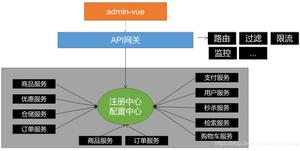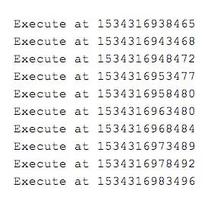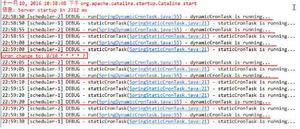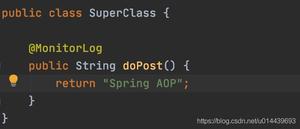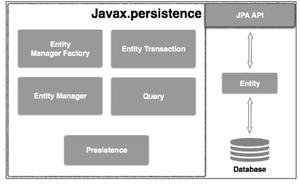10 Spring框架--基于注解的IOC配置
本文内容纲要:10 Spring框架--基于注解的IOC配置
1.工程环境搭建
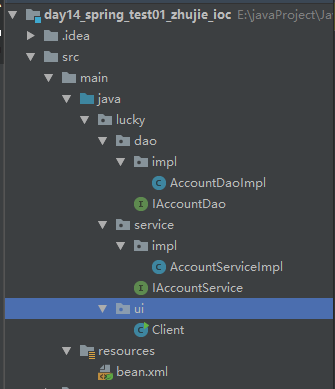
2.基于注解的IOC配置
IOC注解的分类
(1)用于创建对象的
他们的作用就和在XML配置文件中编写一个
@Component:
作用:用于把当前类对象存入spring容器中
属性:
value:用于指定bean的id。当我们不写时,它的默认值是当前类名,且首字母改小写。
业务层实现类:AccountServiceImpl.javapackage lucky.service.impl;
import lucky.service.IAccountService;
import org.springframework.stereotype.Component;
/**
* 账户的业务层实现类
* xml的ioc配置
* <bean id="accountService" class="service.impl.AccountServiceImpl"></bean>
* <bean id="accountDao" class="dao.impl.AccountDaoImpl"></bean>
*/
@Component
public class AccountServiceImpl implements IAccountService {
public AccountServiceImpl(){
System.out.println("对象创建了");
}
public void saveAccount(){
System.out.println("AccountServiceImpl中的saveAccount方法执行了");
}
}
表现层:
package lucky.ui;import lucky.service.IAccountService;
import org.springframework.context.ApplicationContext;
import org.springframework.context.support.ClassPathXmlApplicationContext;
/**
* 模拟一个表现层,用于调用业务层
*/
public class Client {
public static void main(String[] args) {
//1.获取核心容器对象
ApplicationContext ac = new ClassPathXmlApplicationContext("bean.xml");
//2.根据id获取Bean对象,注意id是在bean.xml文件配置的
IAccountService as = (IAccountService)ac.getBean("accountServiceImpl");
System.out.println(as);
// as.saveAccount();
}
}
bean.xml文件配置
<?xml version="1.0" encoding="UTF-8"?><beans xmlns="http://www.springframework.org/schema/beans"
xmlns:xsi="http://www.w3.org/2001/XMLSchema-instance"
xmlns:context="http://www.springframework.org/schema/context"
xsi:schemaLocation="http://www.springframework.org/schema/beans
http://www.springframework.org/schema/beans/spring-beans.xsd
http://www.springframework.org/schema/context
http://www.springframework.org/schema/context/spring-context.xsd">
<!--告知spring在创建容器时要扫描的包,配置所需要的标签不是在beans的约束中,而是一个名称为
context名称空间和约束中-->
<context:component-scan base-package="lucky"></context:component-scan>
</beans>
@ Controller:一般用在表现层
@ Service:一般用在业务层
@ Repository:一般用在持久层
持久层实现类:
package lucky.dao.impl;import lucky.dao.IAccountDao;
import org.springframework.stereotype.Repository;
/**
* 账户的持久层实现类
*/
@Repository
public class AccountDaoImpl implements IAccountDao {
public void saveAccount(){
System.out.println("保存了账户");
}
}
表现层:
package lucky.ui;import lucky.dao.IAccountDao;
import lucky.service.IAccountService;
import org.springframework.context.ApplicationContext;
import org.springframework.context.support.ClassPathXmlApplicationContext;
/**
* 模拟一个表现层,用于调用业务层
*/
public class Client {
/**
* 获取spring的Ioc核心容器,并根据id获取对象
*
* ApplicationContext的三个常用实现类:
* ClassPathXmlApplicationContext:它可以加载类路径下的配置文件,要求配置文件必须在类路径下。不在的话,加载不了。(更常用)
* FileSystemXmlApplicationContext:它可以加载磁盘任意路径下的配置文件(必须有访问权限)
*
* AnnotationConfigApplicationContext:它是用于读取注解创建容器的,是明天的内容。
*
* 核心容器的两个接口引发出的问题:
* ApplicationContext: 单例对象适用 采用此接口
* 它在构建核心容器时,创建对象采取的策略是采用立即加载的方式。也就是说,只要一读取完配置文件马上就创建配置文件中配置的对象。
*
* BeanFactory: 多例对象使用
* 它在构建核心容器时,创建对象采取的策略是采用延迟加载的方式。也就是说,什么时候根据id获取对象了,什么时候才真正的创建对象。
* @param args
*/
public static void main(String[] args) {
//1.获取核心容器对象
ApplicationContext ac = new ClassPathXmlApplicationContext("bean.xml");
//2.根据id获取Bean对象,注意id是在bean.xml文件配置的
IAccountService as = (IAccountService)ac.getBean("accountServiceImpl");
IAccountDao ad = (IAccountDao)ac.getBean("accountDaoImpl");
System.out.println(as);
System.out.println(ad);
// as.saveAccount();
}
}
以上三个注解他们的作用和属性与Component是一模一样。
他们三个是spring框架为我们提供明确的三层使用的注解,使我们的三层对象更加清晰
(2)用于注入数据的
他们的作用就和在xml配置文件中的bean标签中写一个
@Autowired:
作用:自动按照类型注入。只要容器中有唯一的一个bean对象类型和要注入的变量类型匹配,就可以注入成功
如果ioc容器中没有任何bean的类型和要注入的变量类型匹配,则报错。
如果Ioc容器中有多个类型匹配时:会报错(解决方案:配合@Qualifier的注解使用,指定具体用哪个类型)
出现位置:
可以是变量上,也可以是方法上
package lucky.service.impl;import lucky.dao.IAccountDao;
import lucky.service.IAccountService;
import org.springframework.beans.factory.annotation.Autowired;
import org.springframework.stereotype.Component;
/**
* 账户的业务层实现类
* xml的ioc配置
* <bean id="accountService" class="service.impl.AccountServiceImpl"></bean>
* <bean id="accountDao" class="dao.impl.AccountDaoImpl"></bean>
*/
@Component
public class AccountServiceImpl implements IAccountService {
@Autowired
private IAccountDao iAccountDao;
public void saveAccount(){
iAccountDao.saveAccount();
}
}
细节:
在使用注解注入时,set方法就不是必须的了。
@ Qualifier:
作用:在按照类中注入的基础之上再按照名称注入。它在给类成员注入时不能单独使用。但是在给方法参数注入时可以
属性:
value:用于指定注入bean的id。
举例:
有两个IAccountDao实现类时
AccountDaoImpl.java
package lucky.dao.impl;import lucky.dao.IAccountDao;
import org.springframework.stereotype.Repository;
/**
* 账户的持久层实现类
*/
@Repository(value = "accountDao1")
public class AccountDaoImpl implements IAccountDao {
public void saveAccount(){
System.out.println("保存了账户--AccountDaoImpl");
}
}
AccountDaoImpl2.java
package lucky.dao.impl;import lucky.dao.IAccountDao;
import org.springframework.stereotype.Repository;
/**
* 账户的持久层实现类
*/
@Repository(value = "accountDao2")
public class AccountDaoImpl2 implements IAccountDao {
public void saveAccount(){
System.out.println("保存了账户--AccountDaoImpl2");
}
}
业务层实现类
package lucky.service.impl;import lucky.dao.IAccountDao;
import lucky.service.IAccountService;
import org.springframework.beans.factory.annotation.Autowired;
import org.springframework.beans.factory.annotation.Qualifier;
import org.springframework.stereotype.Component;
/**
* 账户的业务层实现类
* xml的ioc配置
* <bean id="accountService" class="service.impl.AccountServiceImpl"></bean>
* <bean id="accountDao" class="dao.impl.AccountDaoImpl"></bean>
*/
@Component
public class AccountServiceImpl implements IAccountService {
//@Qualifier("accountDao1")指定用AccountDaoImpl生成的对象注入
@Autowired
@Qualifier("accountDao1")
private IAccountDao iAccountDao;
public void saveAccount(){
iAccountDao.saveAccount();
}
}
表现层
package lucky.ui;import lucky.dao.IAccountDao;
import lucky.service.IAccountService;
import org.springframework.context.ApplicationContext;
import org.springframework.context.support.ClassPathXmlApplicationContext;
/**
* 模拟一个表现层,用于调用业务层
*/
public class Client {
public static void main(String[] args) {
//1.获取核心容器对象
ApplicationContext ac = new ClassPathXmlApplicationContext("bean.xml");
//2.根据id获取Bean对象,注意id是在bean.xml文件配置的
IAccountService as = (IAccountService)ac.getBean("accountServiceImpl");
// IAccountDao ad = (IAccountDao)ac.getBean("accountDaoImpl");
// System.out.println(as);
// System.out.println(ad);
as.saveAccount();
}
}
效果图:

@ Resource
作用:直接按照bean的id注入。它可以独立使用
属性:
name:用于指定bean的id。
package lucky.service.impl;import lucky.dao.IAccountDao;
import lucky.service.IAccountService;
import org.springframework.beans.factory.annotation.Autowired;
import org.springframework.beans.factory.annotation.Qualifier;
import org.springframework.stereotype.Component;
import javax.annotation.Resource;
/**
* 账户的业务层实现类
* xml的ioc配置
* <bean id="accountService" class="service.impl.AccountServiceImpl"></bean>
* <bean id="accountDao" class="dao.impl.AccountDaoImpl"></bean>
*/
@Component
public class AccountServiceImpl implements IAccountService {
//指定用id为accountDao2所对应的AccountDaoImpl2生成的对象注入
@Resource(name = "accountDao2")
private IAccountDao iAccountDao;
public void saveAccount(){
iAccountDao.saveAccount();
}
}
以上三个注入都只能注入其他bean类型的数据,而基本类型和String类型无法使用上述注解实现。
另外,集合类型的注入只能通过XML来实现。
@ Value
作用:用于注入基本类型和String类型的数据
属性:
value:用于指定数据的值。它可以使用spring中SpEL(也就是spring的el表达式)
SpEL的写法:${表达式}
(3)用于改变作用范围的
他们的作用就和在bean标签中使用scope属性实现的功能是一样的
@Scope
作用:用于指定bean的作用范围
属性:
value:指定范围的取值。常用取值:singleton prototype
*
(4)和生命周期相关 了解
他们的作用就和在bean标签中使用init-method和destroy-methode的作用是一样的
PreDestroy
作用:用于指定销毁方法
PostConstruct
作用:用于指定初始化方法
本文内容总结:10 Spring框架--基于注解的IOC配置
原文链接:https://www.cnblogs.com/luckyplj/p/11316495.html
以上是 10 Spring框架--基于注解的IOC配置 的全部内容, 来源链接: utcz.com/z/296226.html

